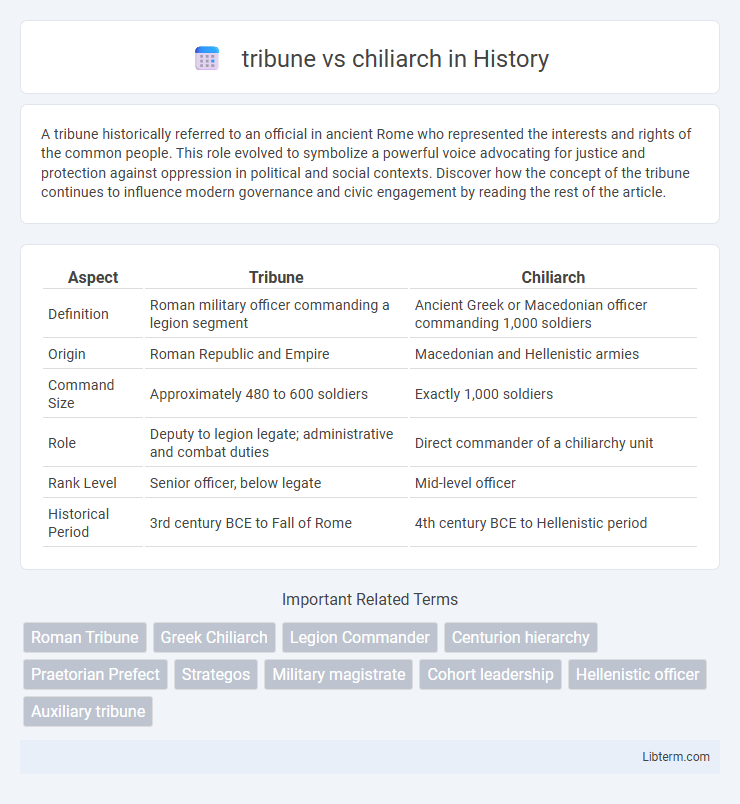A tribune historically referred to an official in ancient Rome who represented the interests and rights of the common people. This role evolved to symbolize a powerful voice advocating for justice and protection against oppression in political and social contexts. Discover how the concept of the tribune continues to influence modern governance and civic engagement by reading the rest of the article.
Table of Comparison
| Aspect | Tribune | Chiliarch |
|---|---|---|
| Definition | Roman military officer commanding a legion segment | Ancient Greek or Macedonian officer commanding 1,000 soldiers |
| Origin | Roman Republic and Empire | Macedonian and Hellenistic armies |
| Command Size | Approximately 480 to 600 soldiers | Exactly 1,000 soldiers |
| Role | Deputy to legion legate; administrative and combat duties | Direct commander of a chiliarchy unit |
| Rank Level | Senior officer, below legate | Mid-level officer |
| Historical Period | 3rd century BCE to Fall of Rome | 4th century BCE to Hellenistic period |
Introduction to Tribune and Chiliarch
A Tribune was a military or political officer in ancient Rome, often serving as a commander of a cohort or as a representative for the plebeians, with roles varying between tribunus militum (military tribune) and tribunus plebis (plebeian tribune). The Chiliarch, originating from ancient Macedonian and Persian military structures, functioned as a tactical commander commanding approximately one thousand soldiers, reflecting a rank similar to a modern battalion leader. Both positions highlight hierarchical military and administrative roles pivotal in their respective ancient civilizations' command and governance systems.
Historical Origins of Tribune
The historical origins of the tribune trace back to the Roman Republic, where tribunes were established as magistrates protecting plebeian rights against patrician magistrates and the Senate. Unlike the chiliarch, a Greek military commander typically in charge of a thousand soldiers, the tribune held civic authority focused on legal and political advocacy rather than direct military command. The tribune's role evolved to include veto power and the ability to convene the popular assembly, marking a significant development in Roman political structure.
The Emergence of the Chiliarch
The emergence of the chiliarch marked a significant evolution in ancient military and administrative hierarchy, distinguishing itself from the traditional tribune role by commanding a thousand soldiers, as opposed to a smaller contingent under a tribune. This shift reflected the increasing complexity and scale of Hellenistic armies, particularly in the Seleucid Empire, where the chiliarch operated as a key strategic and logistical officer, effectively bridging command between high generals and lower-ranking officers. The chiliarch's role expanded beyond military duties to include administrative and fiscal responsibilities, enhancing centralized control and efficiency in large, diverse territories.
Roles and Responsibilities: Tribune
A Tribune in ancient Rome primarily served as a protector of plebeian rights, wielding the power to veto decisions by magistrates and Senate that threatened the common people. Tribunes could convene the Plebeian Council, propose legislation, and acted as intermediaries between the plebeians and patrician class. Their role was fundamentally political and legal, ensuring social equity and safeguarding civil liberties within the Roman Republic.
Duties and Authority: Chiliarch
A chiliarch commanded a unit of one thousand soldiers, wielding significant military authority in training, discipline, and battlefield tactics critical to unit cohesion and effectiveness. Unlike the tribune, whose role often combined administrative and political responsibilities, the chiliarch's duties were primarily operational, directly overseeing combat readiness and execution of strategic orders. This focused command structure allowed the chiliarch to maintain strict control over morale, logistics, and deployment within the ranks.
Comparative Hierarchical Status
The tribune held a senior position within the Roman military and political system, often commanding cohorts or representing plebeian interests, while the chiliarch was a subordinate officer typically commanding a thousand troops within Hellenistic armies. Hierarchically, the tribune outranked the chiliarch due to broader administrative and strategic responsibilities beyond battlefield command. The distinction underscores the tribune's pivotal role in both military leadership and civic governance compared to the more narrowly focused chiliarch.
Geographic and Cultural Contexts
The tribune and chiliarch were military ranks rooted in distinct geographic and cultural contexts, with the tribune prominent in ancient Rome and the chiliarch primarily associated with Hellenistic and Byzantine military frameworks. Roman tribunes held both administrative and military authority, reflecting Rome's emphasis on a structured republican and later imperial system, while chiliarchs, particularly in Eastern Mediterranean regions, commanded units of a thousand soldiers, showcasing a more Hellenistic approach to military organization. These ranks illustrate how regional military traditions and governance shaped the roles and functions of officers across different civilizations.
Impact on Military Structures
The tribune held a key role in shaping Roman military organization by commanding cohorts and managing administrative duties, thus streamlining command hierarchy and enhancing operational efficiency. The chiliarch, primarily a commander of a thousand troops in Hellenistic and later Roman military contexts, influenced battlefield tactics through direct leadership of substantial infantry units. The distinction in their roles reflects evolving military structures where tribunes integrated broader strategic oversight, while chiliarchs contributed specialized command within tactical units.
Legacy and Influence in Modern Terms
The Roman Tribune's legacy endures in modern concepts of representative democracy and citizen advocacy, reflecting its foundational role in protecting plebeian rights against elite dominance. The Chiliarch, a key military commander in ancient armies, influenced contemporary military hierarchy and the structuring of command units, paralleling modern battalion leaders. Both titles underscore the evolution of leadership roles, embodying principles of governance and defense that resonate through today's political and military institutions.
Conclusion: Key Differences and Similarities
Tribunes and chiliarchs both served as military leaders, but tribunes typically commanded Roman legions while chiliarchs led units of a thousand soldiers, reflecting their Greek and Hellenistic origins. Both ranks held significant authority, yet tribunes often had broader administrative and political roles compared to the primarily tactical focus of chiliarchs. Their similarities lie in their leadership responsibilities and the hierarchical position within their respective military structures.
tribune Infographic

 libterm.com
libterm.com